Timeline of the evolutionary history of life
It has been suggested that portions of Geologic time scale (Table of geologic time) be split from it and merged into this article. (Discuss) (November 2023) |
The timeline of the evolutionary history of life represents the current scientific theory outlining the major events during the development of life on planet Earth. Dates in this article are consensus estimates based on scientific evidence, mainly fossils.
In
There has been controversy between more traditional views of steadily increasing biodiversity, and a newer view of cycles of annihilation and diversification, so that certain past times, such as the Cambrian explosion, experienced maximums of diversity followed by sharp winnowing.[7][8]
Extinction
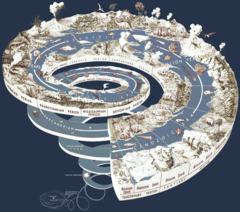
Species go extinct constantly as environments change, as organisms compete for environmental niches, and as genetic mutation leads to the rise of new species from older ones. At long irregular intervals, Earth's biosphere suffers a catastrophic die-off, a
The first known mass extinction was the Great Oxidation Event 2.4 billion years ago, which killed most of the planet's obligate anaerobes. Researchers have identified five other major extinction events in Earth's history, with estimated losses below:[11]
- End Ordovician: 440 million years ago, 86% of all species lost, including graptolites
- Late Devonian: 375 million years ago, 75% of species lost, including most trilobites
- synapsids
- End Triassic: 200 million years ago, 80% of species lost, including all conodonts
Smaller extinction events have occurred in the periods between, with some dividing geologic time periods and epochs. The Holocene extinction event is currently under way.[12]
Factors in mass extinctions include
Detailed timeline
In this timeline,
Hadean Eon

4540 Ma – 4000 Ma
| Date | Event |
|---|---|
| 4540 Ma | accretion disc revolving around the young Sun, perhaps preceded by formation of organic compounds necessary for life in the surrounding protoplanetary disk of cosmic dust.[13][14]
|
| 4510 Ma | According to the giant-impact hypothesis, the Moon originated when Earth and the hypothesized planet Theia collided, sending into orbit myriad moonlets which eventually coalesced into our single Moon.[15][16] The Moon's gravitational pull stabilised Earth's fluctuating axis of rotation, setting up regular climatic conditions favoring abiogenesis.[17] |
| 4404 Ma | Evidence of the first liquid water on Earth which were found in the oldest known zircon crystals.[18] |
| 4280–3770 Ma | Earliest possible appearance of life on Earth.[19][20][21][22] |
Archean Eon
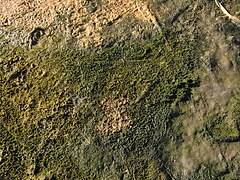

4000 Ma – 2500 Ma
| Date | Event |
|---|---|
| 4100 Ma | Earliest possible preservation of biogenic carbon.[23][24] |
| 4100–3800 Ma | Late Heavy Bombardment (LHB): extended barrage by meteoroids impacting the inner planets. Thermal flux from widespread hydrothermal activity during the LHB may have aided abiogenesis and life's early diversification.[25] Possible remains of biotic life were found in 4.1 billion-year-old rocks in Western Australia.[26][27] Probable origin of life. |
| 4000 Ma | Formation of a Slave craton in northwest Canada - the oldest known rock belt.[28]
|
| 3900–2500 Ma | Cells resembling prokaryotes appear.[29] These first organisms are believed to have been chemoautotrophs, using carbon dioxide as a carbon source and oxidizing inorganic materials to extract energy. |
| 3800 Ma | Formation of a greenstone belt of the metasedimentary rocks in western Greenland;[31] and microbial mat fossils in 3.48 billion-year-old sandstone in Western Australia.[32][33]
|
| 3800–3500 Ma | Last universal common ancestor (LUCA):[34][35] split between bacteria and archaea.[36]
Bacteria develop primitive photosynthesis, which at first did not produce oxygen.[37] These organisms exploit a proton gradient to generate adenosine triphosphate (ATP), a mechanism used by virtually all subsequent organisms.[38][39][40] |
| 3000 Ma | Photosynthesizing Great Oxygenation Event .
|
| 2800 Ma | Oldest evidence for microbial life on land in the form of organic matter-rich paleosols, ephemeral ponds and alluvial sequences, some bearing microfossils.[42] |
Proterozoic Eon
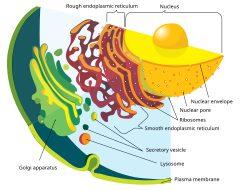

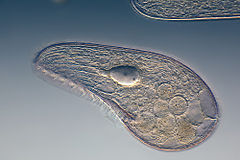

2500 Ma – 539 Ma. Contains the
| Date | Event |
|---|---|
| 2500 Ma | Great Oxidation Event led by cyanobacteria's oxygenic photosynthesis.[41] Commencement of plate tectonics with old marine crust dense enough to subduct.[28] |
| 2023 Ma | Formation of the Vredefort impact structure, one of the largest and oldest verified impact structures on Earth. The crater is estimated to have been between 170–300 kilometres (110–190 mi) across when it first formed.[43] |
| By 1850 Ma | Eukaryotic cells, containing membrane-bound organelles with diverse functions, probably derived from prokaryotes engulfing each other via phagocytosis. (See Symbiogenesis and Endosymbiont). Bacterial viruses (bacteriophages) emerge before or soon after the divergence of the prokaryotic and eukaryotic lineages.[44] Red beds show an oxidising atmosphere, favouring the spread of eukaryotic life.[45][46][47] |
| 1500 Ma | Volyn biota, a collection of exceptionally well-preserved microfossils with varying morphologies.[48] |
| 1300 Ma | Earliest land fungi.[49] |
| By 1200 Ma | |
| By 1000 Ma | First non-marine eukaryotes move onto land. They were photosynthetic and multicellular, indicating that plants evolved much earlier than originally thought.[53] |
| 750 Ma | Beginning of animal evolution.[54][55] |
| 720–630 Ma | Possible global glaciation[56][57] which increased the atmospheric oxygen and decreased carbon dioxide, and was either caused by land plant evolution[58] or resulted in it.[59] Opinion is divided on whether it increased or decreased biodiversity or the rate of evolution.[60][61][62] |
| 600 Ma | Accumulation of atmospheric oxygen allows the formation of an ozone layer.[63] Previous land-based life would probably have required other chemicals to attenuate ultraviolet radiation.[42] |
| 580–542 Ma | Ediacaran biota, the first large, complex aquatic multicellular organisms.[64] |
| 580–500 Ma | Cambrian explosion: most modern animal phyla appear.[65][66] |
| 550–540 Ma | Ctenophora (comb jellies),[67] Porifera (sponges),[68] Anthozoa (corals and sea anemones),[69] Ikaria wariootia (an early Bilaterian).[70] |
Phanerozoic Eon
539 Ma – present
The
Palaeozoic Era
This section needs additional citations for verification. (September 2022) |
538.8 Ma – 251.9 Ma and contains the Cambrian, Ordovician, Silurian, Devonian, Carboniferous and Permian periods.
| Date | Event |
|---|---|
| 535 Ma | , etc. |
| 530 Ma | The first known footprints on land date to 530 Ma.[74] |
| 520 Ma | Earliest graptolites.[75]
|
| 511 Ma | Earliest crustaceans.[76] |
| 505 Ma | Fossilization of the Burgess Shale |
| 500 Ma | Jellyfish have existed since at least this time. |
| 485 Ma | First vertebrates with true bones (jawless fishes). |
| 450 Ma | First complete conodonts and echinoids appear. |
| 440 Ma | First agnathan fishes: Heterostraci, Galeaspida, and Pituriaspida. |
| 420 Ma | Earliest ray-finned fishes, trigonotarbid arachnids, and land scorpions.[77] |
| 410 Ma | First signs of teeth in fish. Earliest lycophytes, and trimerophytes .
|
| 488–400 Ma | First cephalopods (nautiloids)[78] and chitons.[79] |
| 395 Ma | First lichens, stoneworts. Earliest harvestmen, mites, hexapods (springtails) and ammonoids. The earliest known tracks on land named the Zachelmie trackways which are possibly related to icthyostegalians.[80] |
| 375 Ma | Tiktaalik, a lobe-finned fish with some anatomical features similar to early tetrapods. It has been suggested to be a transitional species between fish and tetrapods.[81] |
| 365 Ma | Acanthostega is one of the earliest vertebrates capable of walking.[82] |
| 363 Ma | By the start of the seed-bearing plants and forests soon to flourish.
Four-limbed tetrapods gradually gain adaptations which will help them occupy a terrestrial life-habit. |
| 360 Ma | First crabs and ferns. Land flora dominated by seed ferns. The Xinhang forest grows around this time.[84] |
| 350 Ma | First large sharks, tetrapods (with five digits and no fins and scales).
|
| 350 Ma | Diversification of amphibians.[85] |
| 325-335 Ma | First Reptiliomorpha.[86] |
| 330-320 Ma | First amniote vertebrates (Paleothyris).[87] |
| 320 Ma | Synapsids (precursors to mammals) separate from sauropsids (reptiles) in late Carboniferous.[88]
|
| 305 Ma | The Carboniferous rainforest collapse occurs, causing a minor extinction event, as well as paving the way for amniotes to become dominant over amphibians and seed plants over ferns and lycophytes.
First diapsid reptiles (e.g. Petrolacosaurus). |
| 280 Ma | Earliest sphenopsids decrease. Terrestrial temnospondyl amphibians and pelycosaurs (e.g. Dimetrodon ) diversify in species.
|
| 275 Ma | Therapsid synapsids separate from pelycosaur synapsids. |
| 265 Ma | Gorgonopsians appear in the fossil record.[89] |
| 251.9–251.4 Ma | The Permian–Triassic extinction event eliminates over 90-95% of marine species. Terrestrial organisms were not as seriously affected as the marine biota. This "clearing of the slate" may have led to an ensuing diversification, but life on land took 30 million years to completely recover.[90] |
Mesozoic Era
This section needs additional citations for verification. (September 2022) |
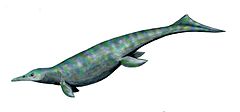
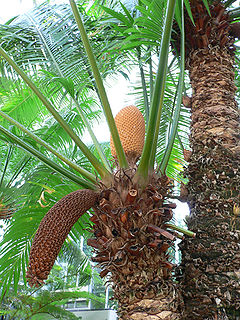
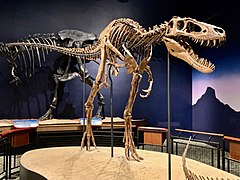
From 251.9 Ma to 66 Ma and containing the Triassic, Jurassic and Cretaceous periods.
| Date | Event |
|---|---|
| 250 Ma | sessile marine groups; the "balance of power" in the oceans shifts dramatically as some groups of prey adapt more rapidly and effectively than others.
|
| 250 Ma | Triadobatrachus massinoti is the earliest known frog.
|
| 248 Ma | Acipenseridae ) first appear.
|
| 245 Ma | Earliest ichthyosaurs |
| 240 Ma | Increase in diversity of cynodonts and rhynchosaurs |
| 225 Ma | Earliest dinosaurs ( teleost fishes. First mammals (Adelobasileus ).
|
| 220 Ma | Seed-producing mammals from small-sized cynodonts , which transitioned towards a nocturnal, insectivorous, and endothermic lifestyle.
|
| 205 Ma | pterosaurs filled the air.
|
| 200 Ma | First accepted evidence for viruses infecting eukaryotic cells (the group Geminiviridae).[91] However, viruses are still poorly understood and may have arisen before "life" itself, or may be a more recent phenomenon.
Major extinctions in terrestrial vertebrates and large amphibians. Earliest examples of armoured dinosaurs. |
| 195 Ma | First pterosaurs with specialized feeding ( fabrosaurids, and scelidosaurids .
|
| 190 Ma | Pliosauroids appear in the fossil record. First lepidopteran insects (Archaeolepis), hermit crabs, modern starfish, irregular echinoids, corbulid bivalves, and tubulipore bryozoans. Extensive development of sponge reefs. |
| 176 Ma | First Stegosaurian dinosaurs. |
| 170 Ma | Earliest plesiosaurs, and cladotherian mammals. Sauropod dinosaurs diversify.
|
| 168 Ma | First lizards. |
| 165 Ma | First rays and glycymeridid bivalves. First vampire squids.[92] |
| 163 Ma | Pterodactyloid pterosaurs first appear.[93] |
| 161 Ma | Ceratopsian dinosaurs appear in the fossil record (Yinlong) and the oldest known eutherian mammal: Juramaia. |
| 160 Ma | Multituberculate mammals (genus Rugosodon) appear in eastern China. |
| 155 Ma | First blood-sucking insects ( theropod dinosaurs.
|
| 131 Ma | First pine trees. |
| 140 Ma | Orb-weaver spiders appear. |
| 135 Ma | Rise of the angiosperms. Some of these flowering plants bear structures that attract insects and other animals to spread pollen; other angiosperms are pollinated by wind or water. This innovation causes a major burst of animal coevolution. First freshwater pelomedusid turtles. Earliest krill. |
| 120 Ma | Oldest fossils of heterokonts, including both marine diatoms and silicoflagellates .
|
| 115 Ma | First monotreme mammals. |
| 114 Ma | Earliest bees.[94] |
| 112 Ma | Xiphactinus, a large predatory fish, appears in the fossil record. |
| 110 Ma | First hesperornithes, toothed diving birds. Earliest limopsid, verticordiid, and thyasirid bivalves. |
| 100 Ma | First ants.[95] |
| 100–95 Ma | Spinosaurus, the largest theropod dinosaur, appears in the fossil record.[96] |
| 95 Ma | First crocodilians evolve.[97] |
| 90 Ma | Extinction of ichthyosaurs. Earliest snakes and nuculanid bivalves. Large diversification in angiosperms: magnoliids, rosids, hamamelidids, monocots, and ginger. Earliest examples of ticks. Probable origins of placental mammals (earliest undisputed fossil evidence is 66 Ma). |
| 86–76 Ma | Diversification of therian mammals.[98][99] |
| 70 Ma | Multituberculate mammals increase in diversity. First ungulates (Protungulatum).
|
| 68–66 Ma | Tyrannosaurus, the largest terrestrial predator of western North America, appears in the fossil record. First species of Triceratops.[100] |
Cenozoic Era
This section needs additional citations for verification. (September 2022) |
66 Ma – present


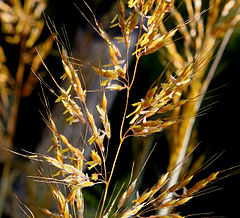
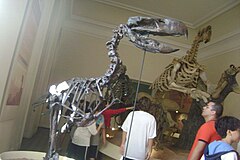
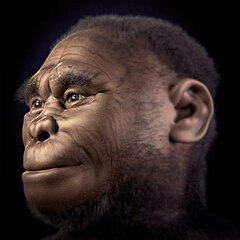
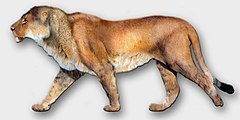
| Date | Event |
|---|---|
| 66 Ma | The ammonites, belemnites, rudist and inoceramid bivalves, most planktic foraminifers, and all of the dinosaurs excluding the birds.[101]
|
| 66 Ma- | Rapid dominance of conifers and ginkgos in high latitudes, along with mammals becoming the dominant species. First psammobiid bivalves. Earliest rodents . Rapid diversification in ants.
|
| 63 Ma | Evolution of the creodonts, an important group of meat-eating (carnivorous) mammals. |
| 62 Ma | Evolution of the first penguins. |
| 60 Ma | Diversification of large, miacids) were alive.[citation needed ]
|
| 59 Ma | Earliest sailfish appear. |
| 56 Ma | Gastornis, a large flightless bird, appears in the fossil record. |
| 55 Ma | Modern bird groups diversify (first artiodactyla and perissodactyla, with some members of the former returning to the sea.
|
| 52 Ma | First bats appear (Onychonycteris). |
| 50 Ma | Peak diversity of dinoflagellates and appear in the fossil record, diversification of primates. |
| 40 Ma | Modern-type moths appear. Extinction of Gastornis. Basilosaurus , one of the first of the giant whales, appeared in the fossil record.
|
| 38 Ma | Earliest bears. |
| 37 Ma | First ruminants .
|
| 35 Ma | whales. |
| 33 Ma | Evolution of the thylacinid marsupials (Badjcinus). |
| 30 Ma | First balanids and eucalypts, extinction of embrithopod and brontothere mammals, earliest pigs and cats. |
| 28 Ma | Paraceratherium appears in the fossil record, the largest terrestrial mammal that ever lived. First pelicans. |
| 25 Ma | Pelagornis sandersi appears in the fossil record, the largest flying bird that ever lived.
|
| 25 Ma | First deer. |
| 24 Ma | First pinnipeds. |
| 23 Ma | Earliest |
| 20 Ma | First giraffes, hyenas, and giant anteaters, increase in bird diversity. |
| 17 Ma | First birds of the genus Corvus (crows). |
| 15 Ma | Genus . |
| 10 Ma | Grasslands and savannas are established, diversity in insects, especially ants and termites, horses increase in body size and develop high-crowned teeth, major diversification in grassland mammals and snakes. |
| 9.5 Ma [dubious ] | and deer entered South America. |
| 9 Ma | First platypuses. |
| 6.5 Ma | First hominins (Sahelanthropus). |
| 6 Ma | Australopithecines diversify (Orrorin, Ardipithecus). |
| 5 Ma | First tree sloths and hippopotami, diversification of grazing herbivores like zebras and elephants, large carnivorous mammals like lions and the genus Canis, burrowing rodents, kangaroos, birds, and small carnivores, vultures increase in size, decrease in the number of perissodactyl mammals. Extinction of nimravid carnivores. First leopard seals. |
| 4.8 Ma | Mammoths appear in the fossil record. |
| 4.5 Ma | Marine iguanas diverge from land iguanas. |
| 4 Ma | Australopithecus evolves. Stupendemys appears in the fossil record as the largest freshwater turtle, first modern elephants, giraffes, zebras, lions, rhinoceros and gazelles appear in the fossil record |
| 3.6 Ma | Blue whales grow to modern size. |
| 3 Ma | Earliest swordfish. |
| 2.7 Ma | Paranthropus evolves. |
| 2.5 Ma | Earliest species of Arctodus and Smilodon evolve. |
| 2 Ma | First members of genus Homo, Homo Habilis, appear in the fossil record. Diversification of conifers in high latitudes. The eventual ancestor of cattle, aurochs (Bos primigenus), evolves in India. |
| 1.7 Ma | Australopithecines go extinct. |
| 1.2 Ma | Evolution of Homo antecessor. The last members of Paranthropus die out. |
| 1 Ma | First coyotes. |
| 810 ka | First wolves
|
| 600 ka | Evolution of Homo heidelbergensis. |
| 400 ka | First polar bears. |
| 350 ka | Evolution of Neanderthals. |
| 300 ka | Gigantopithecus, a giant relative of the orangutan from Asia dies out. |
| 250 ka | Anatomically modern humans appear in Africa.[103][104][105] Around 50 ka they start colonising the other continents, replacing Neanderthals in Europe and other hominins in Asia. |
| 70 ka | Genetic bottleneck in humans (Toba catastrophe theory). |
| 40 ka | Last giant monitor lizards (Varanus priscus) die out. |
| 35-25 ka | Extinction of Neanderthals. Domestication of dogs. |
| 15 ka | Last woolly rhinoceros (Coelodonta antiquitatis) are believed to have gone extinct. |
| 11 ka | Short-faced bears vanish from North America, with the last ungulates .
|
| 10 ka | (Mammuthus primigenus) die out, as does the last Smilodon species. |
| 8 ka | The Giant Lemur dies out. |
See also
References
- ^ McKinney 1997, p. 110
- ISBN 978-0-300-08469-6. Retrieved 30 May 2017.
- ISSN 0362-4331. Archived from the originalon 2022-01-01. Retrieved 2014-12-25.
- ^ Miller & Spoolman 2012, p. 62
- PMID 21886479.
- ^ Staff (2 May 2016). "Researchers find that Earth may be home to 1 trillion species". National Science Foundation. Retrieved 11 April 2018.
- ^ Hickman, Crystal; Starn, Autumn. "The Burgess Shale & Models of Evolution". Reconstructions of the Burgess Shale and What They Mean... Morgantown, WV: West Virginia University. Retrieved 2015-10-18.
- ^ Barton et al. 2007, Figure 10.20 Four diagrams of evolutionary models
- ^ "Measuring the sixth mass extinction - Cosmos". cosmosmagazine.com.
- ^ a b "History of life on Earth". Archived from the original on 2016-08-16. Retrieved 2016-08-09.
- ^ "The big five mass extinctions - Cosmos". cosmosmagazine.com. 5 July 2015.
- ^
PMID 11344283.
- Purch. Retrieved 2012-03-30.
- S2CID 130092094. Retrieved 2022-10-03.
- ^ Herres, Gregg; Hartmann, William K (2010-09-07). "The Origin of the Moon". Planetary Science Institute. Tucson, AZ. Retrieved 2015-03-04.
- PMID 28097222.
- ISSN 2152-1239. Archived from the original on 2015-09-08. Retrieved 2015-03-04.)
Because the Moon helps stabilize the tilt of the Earth's rotation, it prevents the Earth from wobbling between climatic extremes. Without the Moon, seasonal shifts would likely outpace even the most adaptable forms of life.
{{cite journal}}: CS1 maint: unfit URL (link - S2CID 4319774.
- S2CID 2420384.
- ^ Zimmer, Carl (1 March 2017). "Scientists Say Canadian Bacteria Fossils May Be Earth's Oldest". The New York Times. Archived from the original on 2022-01-01. Retrieved 2 March 2017.
- ^ Ghosh, Pallab (1 March 2017). "Earliest evidence of life on Earth 'found'". BBC News. Retrieved 2 March 2017.
- ^ Dunham, Will (1 March 2017). "Canadian bacteria-like fossils called oldest evidence of life". Reuters. Retrieved 1 March 2017.
- ^ "4.1-billion-year-old crystal may hold earliest signs of life". 2015-10-19. Retrieved 2023-08-08.
- PMID 26483481.
- S2CID 3304147. Retrieved 2015-03-04.
- ^ Borenstein, Seth (October 19, 2015). "Hints of life on what was thought to be desolate early Earth". Excite. Yonkers, NY: Mindspark Interactive Network. Associated Press. Retrieved 2015-10-20.
- PMID 26483481. Retrieved 2015-12-30.
- ^ a b c Bjornerud 2005
- ISSN 0036-8733. Retrieved 2015-03-04.
- ^ Nicole Mortilanno. "Oldest traces of life on Earth found in Quebec, dating back roughly 3.8 billion years". CBC News.
- ISSN 1752-0894.
- ^ Borenstein, Seth (November 13, 2013). "Oldest fossil found: Meet your microbial mom". Excite. Yonkers, NY: Mindspark Interactive Network. Associated Press. Retrieved 2013-11-15.
- PMID 24205812.
- PMID 10710791. Archived from the original(PDF) on 2006-09-07. Retrieved 2015-04-05.
- PMID 18613974.
- ISSN 0723-2020.
- S2CID 20364747.
- ^ "Proton Gradient, Cell Origin, ATP Synthase - Learn Science at Scitable". www.nature.com.
- PMID 9084754.
- PMID 6250450.
- ^ PMID 18468984.
- ^ S2CID 44199693.
- ISSN 2169-9097.
- PMID 2651395.
- ^ Bjornerud 2005, p. 151
- PMID 16754612.
- S2CID 55178329.
- doi:10.5194/bg-19-1795-2022.)
{{cite journal}}: CS1 maint: multiple names: authors list (link - ^ "First Land Plants and Fungi Changed Earth's Climate, Paving the Way for Explosive Evolution of Land Animals, New Gene Study Suggests". science.psu.edu. Archived from the original on 2018-04-08. Retrieved 10 April 2018.
The researchers found that land plants had evolved on Earth by about 700 million years ago and land fungi by about 1,300 million years ago — much earlier than previous estimates of around 480 million years ago, which were based on the earliest fossils of those organisms.
- ^ Bernstein, Bernstein & Michod 2012, pp. 1–50
- PMID 6209512.
- S2CID 36648568.
- S2CID 4418860.
- ^ Zimmer, Carl (27 November 2019). "Is This the First Fossil of an Embryo? - Mysterious 609-million-year-old balls of cells may be the oldest animal embryos — or something else entirely". The New York Times. Archived from the original on 2022-01-01. Retrieved 28 November 2019.
- PMID 27918074.
- S2CID 13046760. Retrieved 2007-05-04.
- ^ Kirschvink 1992, pp. 51–52
- ^ "First Land Plants and Fungi Changed Earth's Climate, Paving the Way for Explosive Evolution of Land Animals, New Gene Study Suggests". www.sciencedaily.com. Retrieved 25 May 2022.
- PMID 35154170.
- S2CID 14827354. Archived from the original(PDF) on 2008-09-10. Retrieved 2015-03-09.
- PMID 12682298.
- ISSN 0031-0182.
- ^ "Formation of the Ozone Layer". Goddard Earth Sciences Data and Information Services Center. NASA. September 9, 2009. Retrieved 2013-05-26.
- ^ Narbonne, Guy (January 2008). "The Origin and Early Evolution of Animals". Kingston, Ontario, Canada: Queen's University. Archived from the original on 2015-07-24. Retrieved 2007-03-10.
- ^ Waggoner, Ben M.; Collins, Allen G.; et al. (November 22, 1994). Rieboldt, Sarah; Smith, Dave (eds.). "The Cambrian Period". Tour of geologic time (Online exhibit). Berkeley, CA: University of California Museum of Paleontology. Retrieved 2015-03-09.
- ^ Lane, Abby (January 20, 1999). "Timing". The Cambrian Explosion. Bristol, England: University of Bristol. Retrieved 2015-03-09.
- PMID 17404242.
- S2CID 15471191.
- ^ "Corals and sea anemones (anthozoa)". Smithsonian's National Zoo. 2018-12-11. Retrieved 2022-09-24.
- S2CID 129376371.
- S2CID 85975284. Archived from the original(PDF) on 2015-02-10.
- ^ "Palaeos Paleozoic: Cambrian: The Cambrian Period - 2". Archived from the original on 2009-04-29. Retrieved 2009-04-20.
- ^ "Pteridopsida: Fossil Record". University of California Museum of Paleontology. Retrieved 2014-03-11.
- ISSN 1744-7933. Retrieved 2015-03-09.
The oldest fossils of footprints ever found on land hint that animals may have beaten plants out of the primordial seas. Lobster-sized, centipede-like animals made the prints wading out of the ocean and scuttling over sand dunes about 530 million years ago. Previous fossils indicated that animals didn't take this step until 40 million years later.
- ^ "Graptolites". British Geological Survey. Retrieved 2022-09-24.
- ^ Leutwyler, Kristin. "511-Million-Year-Old Fossil Suggests Pre-Cambrian Origins for Crustaceans". Scientific American. Retrieved 2022-09-24.
- ISSN 1936-6426.
- S2CID 130848432.
- S2CID 2881223.
- S2CID 4428903.
- ^ "Details of Evolutionary Transition from Fish to Land Animals Revealed". www.nsf.gov. Retrieved 2022-09-25.
- PMID 16323697. Archived from the originalon 2007-02-25.
- ^ Martin, R. Aidan. "Evolution of a Super Predator". Biology of Sharks and Rays. North Vancouver, BC, Canada: ReefQuest Centre for Shark Research. Retrieved 2015-03-10.
The ancestry of sharks dates back more than 200 million years before the earliest known dinosaur.
- ^ "Devonian Fossil Forest Unearthed in China | Paleontology | Sci-News.com". Breaking Science News | Sci-News.com. Retrieved 2019-09-28.
- ^ "Amphibia". paleobiodb.org. Retrieved 2022-10-07.
- PMID 17047029.
- ^ "Origin and Early Evolution of Amniotes | Frontiers Research Topic". www.frontiersin.org. Retrieved 2022-10-07.
- ^ "Amniota". Palaeos. Retrieved 2015-03-09.
- S2CID 3184629.
- PMID 18198148.
- ^ Rybicki, Ed (April 2008). "Origins of Viruses". Introduction of Molecular Virology (Lecture). Cape Town, Western Cape, South Africa: University of Cape Town. Archived from the original on 2009-05-09. Retrieved 2015-03-10.
Viruses of nearly all the major classes of organisms - animals, plants, fungi and bacteria / archaea - probably evolved with their hosts in the seas, given that most of the evolution of life on this planet has occurred there. This means that viruses also probably emerged from the waters with their different hosts, during the successive waves of colonisation of the terrestrial environment.
- ^ US Department of Commerce, National Oceanic and Atmospheric Administration. "What are the vampire squid and the vampire fish?". oceanservice.noaa.gov. Retrieved 2019-09-27.
- ^ Dell'Amore, Christine (April 24, 2014). "Meet Kryptodrakon: Oldest Known Pterodactyl Found in China". National Geographic News. Washington, D.C.: National Geographic Society. Archived from the original on April 25, 2014. Retrieved 2014-04-25.
- ^ Greshko, Michael (2020-02-11). "Oldest evidence of modern bees found in Argentina". National Geographic. Archived from the original on February 23, 2021. Retrieved 2022-06-22.
The model shows that modern bees started diversifying at a breakneck pace about 114 million years ago, right around the time that eudicots—the plant group that comprises 75 percent of flowering plants—started branching out. The results, which confirm some earlier genetic studies, strengthen the case that flowering plants and pollinating bees have coevolved from the very beginning.
- S2CID 20729380.
- ^ "Case for 'river monster' Spinosaurus strengthened by new fossil teeth". Science. 2020-09-23. Archived from the original on June 13, 2021. Retrieved 2022-10-03.
- ^ "Mindat.org". www.mindat.org. Retrieved 2022-10-03.
- PMC 4920311.
- ^ "Mammals began their takeover long before the death of the dinosaurs". ScienceDaily. Retrieved 2022-09-25.
- ^ Finds, Study (2021-12-02). "T-rex fossil reveals dinosaur from 68 million years ago likely had a terrible toothache!". Study Finds. Retrieved 2022-09-24.
- ISSN 1545-2069.
- ^ "About > The Origins of Oaks". www.oaksofchevithornebarton.com. Retrieved 2019-09-28.
- PMID 25770088.
- ^ Brown, Frank; Fleagle, John; McDougall, Ian (February 16, 2005). "The Oldest Homo sapiens" (Press release). Salt Lake City, UT: University of Utah. Retrieved 2015-03-10.
- PMID 11815945.
- ^ "International Stratigraphic Chart (v 2014/10)" (PDF). Beijing, China: International Commission on Stratigraphy. Retrieved 2015-03-11.
Bibliography
- OCLC 86090399.
- Bernstein, Harris; Bernstein, Carol; Michod, Richard E. (2012). "DNA Repair as the Primary Adaptive Function of Sex in Bacteria and Eukaryotes". In Kimura, Sakura; Shimizu, Sora (eds.). DNA Repair: New Research. Hauppauge, NY: OCLC 828424701.
- Bjornerud, Marcia (2005). Reading the Rocks: The Autobiography of the Earth. Cambridge, MA: OCLC 56672295.
- Kirschvink, Joseph L. (1992). "Late Proterozoic Low-Latitude Global Glaciation: the Snowball Earth" (PDF). In OCLC 23583672.
- McKinney, Michael L. (1997). "How do rare species avoid extinction? A paleontological view". In Kunin, William E.; Gaston, Kevin J. (eds.). The Biology of Rarity: Causes and consequences of rare—common differences (1st ed.). London; New York: OCLC 36442106.
- Miller, G. Tyler; Spoolman, Scott E. (2012). Environmental Science (14th ed.). Belmont, CA: OCLC 741539226.
- Stearns, Beverly Peterson; OCLC 47011675.
Further reading
- OCLC 56617123.
External links
- "Understanding Evolution: your one-stop resource for information on evolution". University of California, Berkeley. Retrieved 2015-03-18.
- "Life on Earth". Tree of Life Web Project. University of Arizona. January 1, 1997. Retrieved 2015-03-18. Explore complete phylogenetic tree interactively
- Brandt, Niel. "Evolutionary and Geological Timelines". TalkOrigins Archive. Houston, TX: The TalkOrigins Foundation, Inc. Retrieved 2015-03-18.
- "Palaeos: Life Through Deep Time". Palaeos. Retrieved 2015-03-18.
- Kyrk, John. "Evolution" (SWF). Cell Biology Animation. Retrieved 2015-03-18. Interactive timeline from Big Bang to present
- "Plant Evolution". Plant and Animal Evolution. University of Waikato. Retrieved 2015-03-18. Sequence of Plant Evolution
- "The History of Animal Evolution". Plant and Animal Evolution. University of Waikato. Retrieved 2015-03-18. Sequence of Animal Evolution
- Yeo, Dannel; Drage, Thomas (2006). "History of Life on Earth". Archived from the original on 2015-03-15. Retrieved 2015-03-19.
- Exploring Time. The Science Channel. 2007. Retrieved 2015-03-19.
- Roberts, Ben. "Plant evolution timeline". University of Cambridge. Archived from the original on 2015-03-13. Retrieved 2015-03-19.
- Art of the Nature Timelines on Wikipedia
